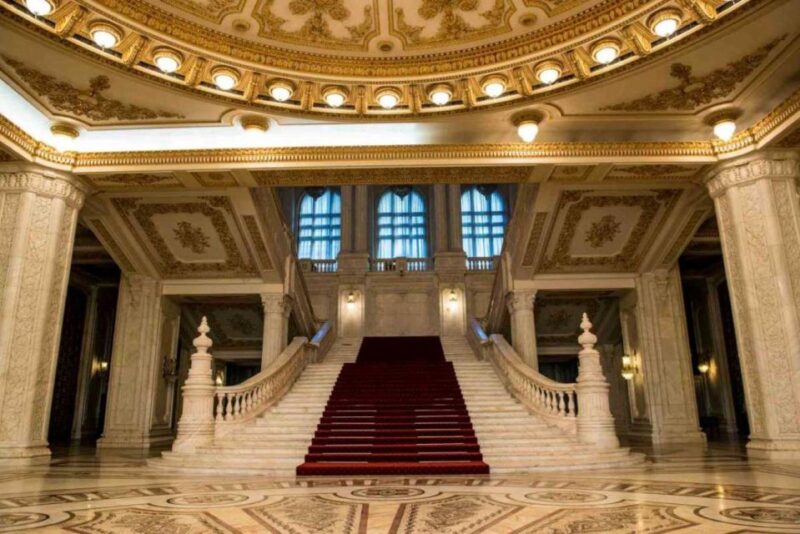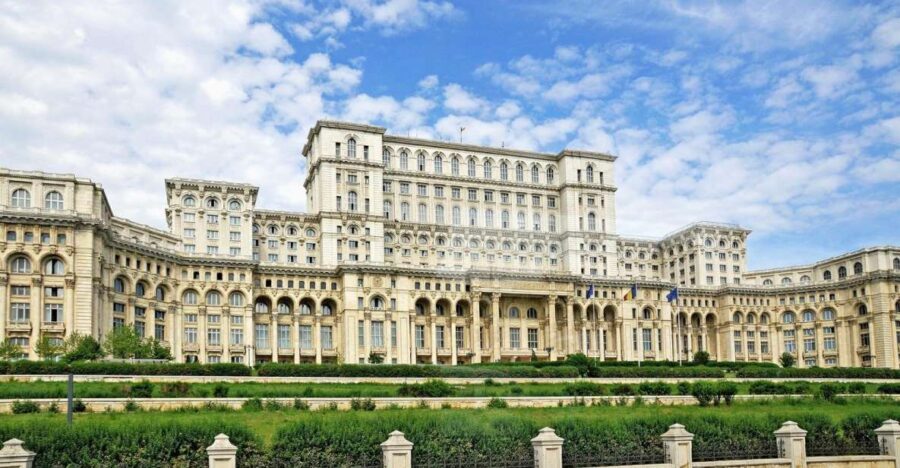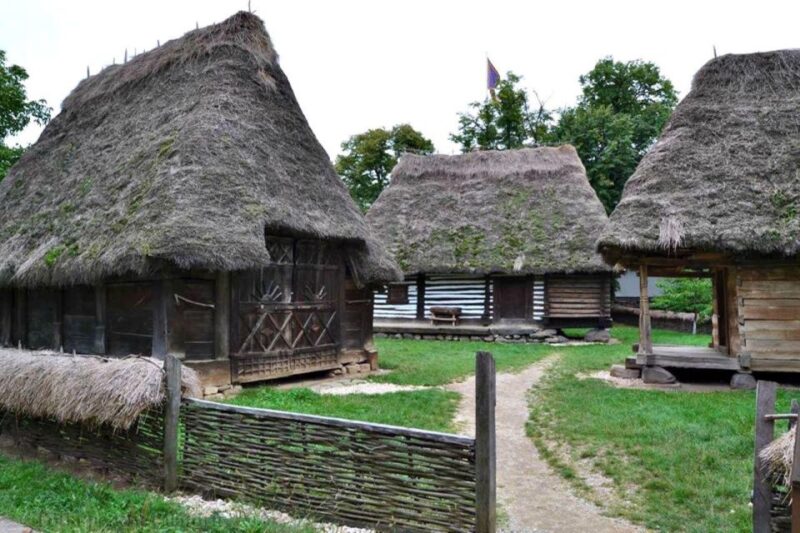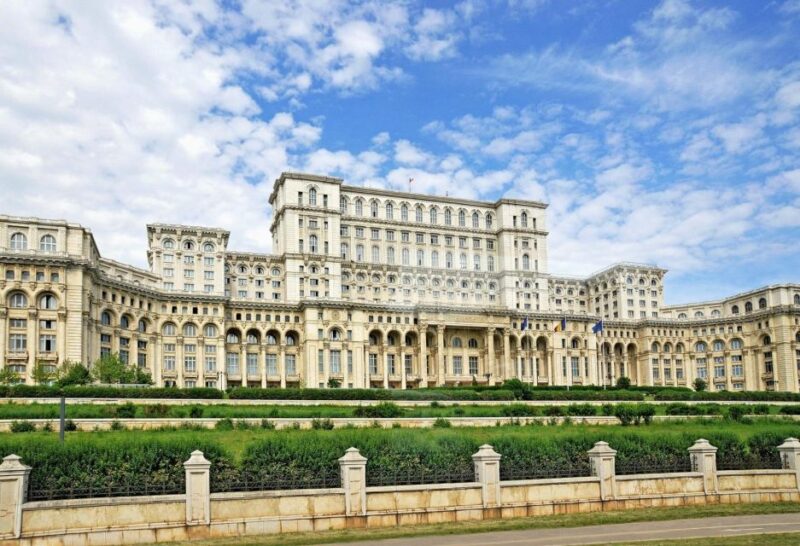Bucharest has long been a city where tradition and communism have collided. Visitors can explore the colossal Palace of Parliament, a symbol of Nicolae Ceausescu’s oppressive regime, juxtaposed with the charming Dimitrie Gusti National Village Museum and the Museum of the Romanian Peasant, which celebrate the country’s rich cultural heritage. This dynamic blend offers a unique insight into Romania’s tumultuous past, showcasing the resilience of its people amidst political upheaval and cultural transformation. What lies beneath the surface, however, is a complex story waiting to be unraveled.
Key Points

- The Bucharest tour offers a comprehensive exploration of the city’s transformation from traditional roots to the communist era under Ceausescu’s rule.
- Key attractions include the Palace of the Parliament, a massive communist-era building, and museums showcasing Romania’s traditional cultural heritage.
- The Dimitrie Gusti National Village Museum provides an open-air exhibition of authentic homesteads, mills, and crafts, highlighting the country’s rural traditions.
- The Museum of the Romanian Peasant features over 90,000 artifacts, offering insights into Romanian folklore, rural lifestyles, and the impact of communism.
- The tour provides a balanced perspective on Bucharest’s history, blending traditional roots and the profound influence of the communist regime.
Tour Overview

This tour typically provides a rundown of Bucharest’s history, exploring the contrast between the city’s traditional roots and its communist-era transformation.
It offers a 4-hour journey through the capital, available in both English and Romanian. Priced from $168.40 per person, the tour is wheelchair accessible and allows for free cancellation up to 24 hours in advance.
Pickup options include the Henri Coanda International Airport and the Palace of the Parliament.
Key attractions visited include the imposing Palace of the Parliament, the Dimitrie Gusti National Village Museum, and the Museum of the Romanian Peasant, which showcases the country’s cultural heritage.
Throughout the experience, travelers can expect knowledgeable guidance and opportunities for personalized tours and photo stops.
You can also read our reviews of more tours and experiences in Bucharest.
Itinerary and Locations

The tour starts with pickup options from either the Henri Coanda International Airport or the Palace of the Parliament, providing convenient access for participants. The main attractions include the Palace of Parliament, a massive structure built by Nicolae Ceausescu between 1984-1989, and two renowned museums – the Dimitrie Gusti National Village Museum and the Museum of the Romanian Peasant. The Palace of Parliament is the second-largest administrative building in the world, with 1,100 rooms and a 328-ft-long lobby. The museums showcase Romania’s rich cultural heritage, with the Dimitrie Gusti Museum displaying traditional homesteads and the Museum of the Romanian Peasant featuring over 90,000 artifacts and communist-era exhibits.
| Palace of Parliament | Dimitrie Gusti Museum | Museum of the Romanian Peasant |
|---|---|---|
| Massive structure | Traditional homesteads | Over 90,000 artifacts |
| 1,100 rooms | Europe’s oldest open-air museum | Awarded Europe’s Best Museum |
| 328-ft-long lobby | Second largest in Europe | Communist-era exhibits |
Main Attractions

The Palace of Parliament, the second-largest administrative building in the world after the Pentagon, is the primary highlight of the tour.
Commissioned by former Romanian dictator Nicolae Ceausescu and built between 1984 and 1989, this massive structure boasts 1,100 rooms and a 328-foot-long lobby.
It hosts the Romanian Senate, the House of Representatives, the Constitutional Court, and the Museum of Contemporary Art.
The palace has also been the venue for notable events, including the 2008 NATO Summit and the 1996 Crans Montana Business Forum.
In contrast, the Dimitrie Gusti National Village Museum and the Museum of the Romanian Peasant offer a glimpse into Romania’s traditional cultural heritage.
Dimitrie Gusti National Village Museum
Nestled within the heart of Bucharest, the Dimitrie Gusti National Village Museum stands as an open-air exhibition that transports visitors back in time, showcasing Romania’s rich cultural heritage through a collection of authentic homesteads, mills, churches, and windmills.
Established in 1936, it’s one of Europe’s oldest open-air museums and the second largest in Europe after Stockholm.
The museum offers a unique glimpse into the traditional way of life, allowing visitors to:
-
Explore authentic rural structures and artifacts
-
Gain insights into Romania’s architectural diversity
-
Witness traditional crafts and folk customs
-
Immerse themselves in the country’s cultural history
Museum of the Romanian Peasant
Regularly recognized as Europe’s Best Museum, the Museum of the Romanian Peasant proudly showcases over 90,000 artifacts that celebrate the country’s rich cultural heritage.
The museum’s extensive collection includes traditional costumes, tools, furniture, and other everyday items used by Romanian peasants throughout history. Visitors can enjoy the country’s vibrant folklore and gain a deeper understanding of the lives of its rural population.
The museum also features communist exhibits, such as Lenin busts and portraits of leaders, providing a unique perspective on Romania’s tumultuous past.
With its award-winning status and diverse collection, the Museum of the Romanian Peasant offers a captivating glimpse into the traditions and resilience of the Romanian people.
Experience Highlights
Visitors can explore Bucharest’s rich history, from its traditional roots to the lasting impacts of communism, under the guidance of a certified guide.
Personalized tours with flexible pickup times and opportunities for photo stops and historical presentations are available upon request.
This experience highlights include:
-
In-depth exploration of Bucharest’s transition from tradition to communism
-
Insights from a knowledgeable guide on the city’s complex past
-
Flexibility to customize the tour to personal interests and preferences
-
Memorable photo opportunities at key historical sites
Whether seeking to understand Romania’s tumultuous 20th century or simply immerse in the city’s fascinating duality, this tour provides an enriching and customizable way to experience Bucharest.
Transportation Details

The tour includes hotel pickup and drop-off, with return transportation to the original departure point or a central location in Bucharest. This convenient transportation arrangement ensures guests don’t have to worry about navigating the city on their own.
The tour provides a seamless experience, with a reliable and efficient transportation service to and from the key sights. Whether you’re starting from your hotel or the airport, the tour will handle the logistics, allowing you to focus on enjoying the fascinating history and contrasts of Bucharest.
The transportation is an integral part of the tour’s comprehensive service, making it a hassle-free way to explore the city’s tradition and communist legacy.
Booking Information
Booking this tour requires no upfront payment, allowing guests to reserve their spot conveniently. Availability can be checked for preferred starting times and participant selection.
The booking process is straightforward:
-
No payment is needed to secure a reservation
-
Guests can easily check tour dates and party size
-
Flexibility is provided with free cancellation up to 24 hours in advance
-
Full refunds are available if plans change
With simple booking and flexible terms, this Bucharest tour makes it easy for visitors to explore the city’s captivating blend of tradition and Communist-era history.
Frequently Asked Questions
What Is the Best Time of Year to Visit Bucharest?
The best time to visit Bucharest is during the spring and fall seasons. The weather is mild, and there are fewer crowds compared to the peak summer months. Visitors can enjoy the city’s sights and cultural events without extreme temperatures.
How Much Time Do Visitors Typically Spend at Each Attraction?
Visitors typically spend 1-2 hours at the Palace of Parliament, 1-2 hours at the Dimitrie Gusti National Village Museum, and 1 hour at the Museum of the Romanian Peasant. The total tour duration is 4 hours.
Are There Any Discounts or Package Deals Available for the Tour?
There are no discounts or package deals specifically mentioned for this tour. However, the tour operator may offer various promotions or bundled packages that could provide savings. Interested customers should check the tour website or contact the operator directly for the latest pricing and offers.
Are There Any Additional Fees or Taxes Not Included in the Tour Price?
The tour price of $168.40 per person includes all necessary fees and taxes. There are no additional charges beyond the listed price. Guests can expect an all-inclusive experience with the option to upgrade or customize their tour as needed.
What Are the Weather Conditions Like in Bucharest During the Tour Season?
The weather in Bucharest during the tour season is generally mild, with average temperatures ranging from 15-25°C (59-77°F). Precipitation is moderate, and visitors can expect a mix of sunny and partly cloudy days.
Recap
Bucharest’s past is a tapestry woven with tradition and communism.
Visitors can explore the colossal Palace of Parliament, a symbol of Nicolae Ceaușescu’s regime, while also experiencing the charm of Romanian culture at the Dimitrie Gusti National Village Museum and the Museum of the Romanian Peasant.
This dynamic blend offers a unique insight into Romania’s evolution, showcasing the resilience of its people amidst political upheaval and cultural transformation.
You can check if your dates are available here:More Tour Reviews in Bucharest
Not for you? Here's more things to do in Bucharest we have recnetly reviewed
- 2 Best Craft Beer Tours And Tastings In Bucharest
- 4 Best Dining Experiences In Bucharest
- 20 Best 2 Day Tours In Bucharest
- 3 Best Dinner Tours In Bucharest
- 20 Best 3 Day Tours In Bucharest
- 20 Best 4 Day Tours In Bucharest
- 3 Best Shopping Tours In Bucharest
- 13 Best Full-Day Tours In Bucharest
- 2 Best Coffee Tours And Tastings In Bucharest
- 6 Best Lunch Experiences In Bucharest
- 13 Best Food Tours In Bucharest
- Veliko Tarnovo and Medieval Bulgaria Private Day Trip From Bucharest
